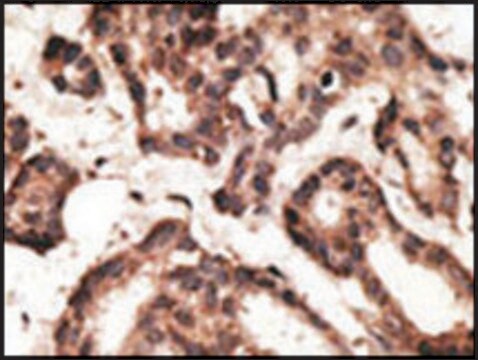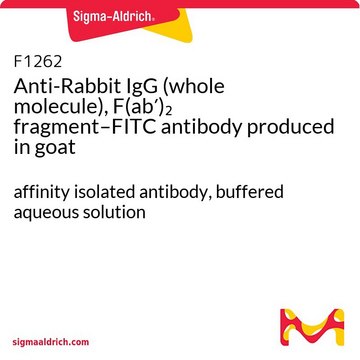L2295
Anti-LRP1 (N-terminal) antibody produced in rabbit
~1.0 mg/mL, affinity isolated antibody, buffered aqueous solution
别名:
Anti-A2MR, Anti-APOER, Anti-APR, Anti-Alpha-2-Macroglobulin receptor, Anti-Apolipoprotein E receptor, Anti-CD91, Anti-LRP, Anti-Low density lipoprotein receptor-related protein 1
登录查看公司和协议定价
所有图片(2)
About This Item
分類程式碼代碼:
12352203
NACRES:
NA.41
推荐产品
生物源
rabbit
共軛
unconjugated
抗體表格
affinity isolated antibody
抗體產品種類
primary antibodies
無性繁殖
polyclonal
形狀
buffered aqueous solution
分子量
antigen ~500 kDa
物種活性
human, mouse, rat
濃度
~1.0 mg/mL
技術
indirect immunofluorescence: 2-5 μg/mL using rat NRK cells
western blot: 1-2 μg/mL using whole extract of human U87 cells
western blot: 2-4 μg/mL using whole extract of mouse C2C12 cells
UniProt登錄號
運輸包裝
dry ice
儲存溫度
−20°C
目標翻譯後修改
unmodified
基因資訊
human ... LRP1(4035)
mouse ... Lrp1(16971)
rat ... Lrp1(299858)
一般說明
LDL receptor-related protein 1 (LRP1), also known as 2-macroglobulin receptor, is a large endocytic receptor, widely expressed on the surface and intracellular membranes of various cells. LRP1 is encoded by the gene mapped to human chromosome 12q13.3. The encoded protein is a member of the LDL receptor family. LRP1 is synthesized in the endoplasmic reticulum as a single-chain 600 kDa type I transmembrane glycosylated precursor that is cleaved subsequently in the Golgi complex into two subunits of 515 kDa and 85 kDa. The 515 kDa N-terminal subunit remains attached to the membrane through noncovalent association with the smaller 85 kDa C-terminal subunit, which contains the transmembrane and cytoplasmic domains.
特異性
Anti-LRP1 (N-terminal) recognizes human, mouse, and rat LRP1 (not tested in other species).
應用
Anti-LRP1 (N-terminal) antibody produced in rabbit has been used in immunoblotting and immunofluorescence.
生化/生理作用
LRP1 expression is essential for early embryonic development. LRP1 facilitates various biological processes including lipoprotein metabolism, proteinase regulation, lysosomal enzymes activation and entry of viruses and toxins into the cells. In addition, It also regulates cell signaling pathways, cell migration, and neurodevelopment. LRP1 has an ability to bind at least 30 different ligands such as lipoproteins, proteinases, proteinase-inhibitor complexes, extra cellular matrix (ECM) proteins and various intracellular proteins. It also binds to bacterial toxins and viruses.
外觀
Solution in 0.01 M phosphate buffered saline pH 7.4, containing 15 mM sodium azide.
儲存和穩定性
Store at –20 °C. For continuous use, the product may be stored at 2–8 °C for up to one month. For extended storage freeze in working aliquots at –20 °C. Repeated freezing and thawing is not recommended. If slight turbidity occurs upon prolonged storage, clarify the solution by centrifugation before use. Working dilution samples should be discarded if not used within 12 hours.
免責聲明
Unless otherwise stated in our catalog, our products are intended for research use only and are not to be used for any other purpose, which includes but is not limited to, unauthorized commercial uses, in vitro diagnostic uses, ex vivo or in vivo therapeutic uses or any type of consumption or application to humans or animals.
未找到合适的产品?
试试我们的产品选型工具.
儲存類別代碼
10 - Combustible liquids
閃點(°F)
Not applicable
閃點(°C)
Not applicable
Involvement of the Apoer2 and Lrp1 receptors in mediating the pathological effects of ApoE4 in vivo.
Moran Gilat-Frenkel et al.
Current Alzheimer research, 11(6), 549-557 (2013-11-21)
This study investigated the possible role of the ApoE receptors Lrp1 and Apoer2 in mediating the pathological effects of ApoE4 in ApoE-targeted-replacement mice expressing either the human ApoE3 or ApoE4 allele. In this study we show that activation of the
Estrogen-enhanced apical and basolateral secretion of apolipoprotein B-100 by polarized trophoblast-derived BeWo cells
Kamper M, et al.
Biochimie, 138(10), 116-123 (2017)
Matvey Gorovoy et al.
Journal of leukocyte biology, 88(4), 769-778 (2010-07-09)
LRP1 is a type-1 transmembrane receptor that mediates the endocytosis of diverse ligands. LRP1 β-chain proteolysis results in release of sLRP1 that is present in human plasma. In this study, we show that LPS and IFN-γ induce shedding of LRP1
Yang Tian et al.
Journal of cell science, 132(15) (2019-07-06)
Extracellular heat shock protein 90 alpha (eHsp90α, also known as HSP90AA1) has been widely reported to promote tumor cell motility and tumor metastasis in various types of cancer. Several extracellular proteins and membrane receptors have been identified as interacting proteins
Beyond endocytosis: LRP function in cell migration, proliferation and vascular permeability
Lillis AP, et al.
Journal of Thrombosis and Haemostasis, 3(8), 1884-1893 (2005)
我们的科学家团队拥有各种研究领域经验,包括生命科学、材料科学、化学合成、色谱、分析及许多其他领域.
联系技术服务部门








